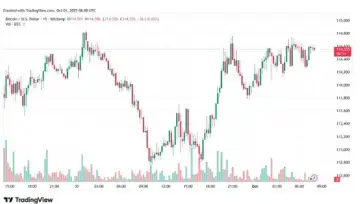Overview
- Bitcoin Price holds near $114,000 after significant September volatility.
- ETF flows remain the strongest driver of the Bitcoin price uptrend.
- Support lies in the range of $103,000 to $108,000, and resistance is at $115,000-$125,000.
Bitcoin price today is hovering near the $114,000 margin, after a very volatile September. The previous month was marked by strong inflows into spot exchange-traded funds (ETFs), sudden sell-offs, and heavy liquidations in the futures market. Despite the turbulence, optimism remains among many investors as long-term demand for Bitcoin is still increasing, especially through regulated investment products.
Recent Price Movements
In September, Bitcoin price moved sharply between highs of nearly $124,000 in August and lows below $110,000 at the end of September. These swings created a lot of liquidations for leveraged traders and pushed volatility higher. Trading activity rose during this period as institutions and retail investors reacted to changes in ETF inflows and macroeconomic developments. By the start of October, the price stabilized near $114,000, though trading volumes show that uncertainty remains high.
Main Drivers of the Market
One of the biggest forces shaping Bitcoin price in recent months has been . The launch of multiple spot Bitcoin ETFs in the United States earlier in 2025 was a turning point. These funds attracted billions of dollars in inflows and gave institutions a safe, regulated way to gain exposure. Even now, ETF demand remains a major support for Bitcoin. However, flows are uneven. Some days see large inflows that push the price higher, while other days record redemptions that pressure the market lower.
The second key factor is macroeconomic policy. Interest rate expectations and US economic data have a direct effect on investor sentiment. When markets believe that central banks will cut rates, demand for risk assets like Bitcoin rises. On the other hand, stronger-than-expected data or hawkish speeches from Federal Reserve officials tend to pull Bitcoin lower. The US dollar also plays a role. Periods of dollar weakness often see Bitcoin rally, while dollar strength makes it harder for Bitcoin to climb.
Another important influence is regulation and politics. While the approval of ETFs earlier this year gave the industry a huge boost, the regulatory environment is still evolving. Discussions within US agencies, political disagreements over the budget, and global rules around digital assets often create bursts of volatility. Headlines about delays, approvals, or policy shifts can move Bitcoin’s price dramatically within hours.
On-Chain and Flow Signals
On-chain data and ETF trackers show mixed signals. Many funds continue to grow their Bitcoin holdings, a sign of strong institutional interest. At the same time, some funds saw withdrawals during September, often tied to profit-taking or portfolio rebalancing. This imbalance between inflows and outflows explains much of the sharp price swings seen during the month.
In the futures market, leveraged positions played a big role in price action. When ETFs recorded outflows, Bitcoin dropped quickly, triggering a wave of among over-leveraged traders. This pushed prices lower than they might have fallen otherwise, highlighting how sensitive the market remains to sudden shocks.
Technical Outlook
From a charting perspective, Bitcoin built clear support and resistance zones in September. Strong buying interest was visible in the $103,000-$108,000 range, where long-term investors and some institutions stepped in. On the upside, heavy resistance appeared in the $115,000-$125,000 zone. Several attempts to break above this range failed, showing that sellers remain active at higher levels.
 Volatility levels remain above the averages seen in 2023 and 2024. This means that once Bitcoin breaks out of its current range, the move could be very fast and aggressive in either direction. Seasonal patterns also matter. Historically, Bitcoin has often performed well in the last quarter of the year, and many traders are positioning with that trend in mind.
Volatility levels remain above the averages seen in 2023 and 2024. This means that once Bitcoin breaks out of its current range, the move could be very fast and aggressive in either direction. Seasonal patterns also matter. Historically, Bitcoin has often performed well in the last quarter of the year, and many traders are positioning with that trend in mind.
Investor Sentiment
Market sentiment is cautiously optimistic. Institutional investors see Bitcoin as a long-term inflation hedge and a scarce digital asset, especially in a world of slowing growth and lower interest rates. Surveys and derivatives pricing show that fear has reduced compared to previous bear markets. However, risk managers still point out that the market is heavily influenced by a small group of large ETF flows, meaning that outflows from a few funds can impact the entire market.
This combination of and short-term caution explains the choppy trading pattern. Investors are willing to accumulate Bitcoin, but they are also quick to reduce exposure if macro or regulatory news turns negative.
Outlook for October and Beyond
Several upcoming events will be crucial for Bitcoin’s direction. US jobs data, inflation reports, and Federal Reserve statements in October will directly affect interest rate expectations. If the data points to economic weakness, markets may price in faster rate cuts, which usually supports Bitcoin.
ETF approvals remain another potential catalyst. Any new product launches or approvals for large asset managers could bring billions of dollars into the market. On the other hand, political gridlock or regulatory delays could create uncertainty and short-term weakness.
Another factor is corporate and fund accumulation. If more companies move Bitcoin into long-term storage or if ETFs continue to steadily increase holdings, the available supply on exchanges will shrink. This structural shortage could support higher prices.
If all these positive drivers align, Bitcoin could move toward the $150,000-$200,000 zone over the next few months. However, risks remain. A sudden tightening in monetary policy, large ETF redemptions, or cascading futures liquidations could quickly drag the price back toward support levels.
Risks to Watch
Despite the strong long-term story, the downside risks cannot be ignored. A hawkish surprise from the Federal Reserve or other central banks could reduce risk appetite. A sharp rise in the US dollar would also hurt Bitcoin. Political uncertainty in the US could delay ETF progress or shake investor confidence.
Another major risk is the market structure itself. With such a large share of Bitcoin demand now concentrated in ETFs, even small shifts in flows can create oversized moves in price. Monitoring funding rates in the futures market, open interest, and daily ETF flow reports will remain critical for anyone following Bitcoin closely.
Final Thoughts
Bitcoin entered October 2025 with a balance of optimism and caution. On the one hand, the long-term picture looks stronger than ever. Institutional adoption is rising, ETFs are pulling in steady demand, and more companies view Bitcoin as a . On the other hand, the market is still vulnerable to short-term shocks from macroeconomic data, politics, or concentrated flows.
Support is clear around $103,000-$108,000, while resistance stands firm between $115,000-$125,000. Breaking out of this range will likely require a strong catalyst, such as a new wave of ETF inflows or a major shift in US monetary policy. Until then, investors should expect volatility and prepare for sharp moves in either direction.
The weeks ahead will likely deliver active trading and fast price discovery. If positive catalysts align, Bitcoin could begin another leg higher. If risks dominate, the market could retest support levels before stabilizing again.
FAQs
1. What is the current Bitcoin Price in October 2025?
As of October 1, 2025, Bitcoin is trading in the range of $113,000-$115,000 after a volatile September marked by ETF inflows and market liquidations.
2. How are Bitcoin ETFs affecting the Bitcoin Price?
Bitcoin ETFs play a major role in price movement. Strong ETF flows often push prices higher, while sudden outflows can create sharp declines.
3. What are the key support and resistance levels for Bitcoin?
Bitcoin shows strong support around $103,000-$108,000 and heavy resistance between $115,000-$125,000 as October begins.
4. Why is Bitcoin so volatile right now?
Volatility is being driven by a mix of ETF demand, macroeconomic signals, and leveraged futures liquidations, making prices swing quickly.
5. What is the outlook for Bitcoin Price in Q4 2025?
If ETF inflows remain strong and macroeconomic conditions turn favorable, Bitcoin could aim for $150,000-$200,000. However, risks from outflows or policy shifts remain.
